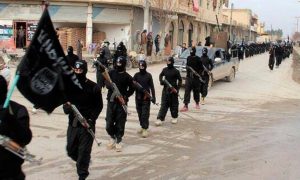 Jason Burke discusses the most recent UN report on the ISIS threat in The Guardian, New wave of terrorist attacks possible before end of year, UN says — UN report warns threat from Islamist extremist groups remains high
Jason Burke discusses the most recent UN report on the ISIS threat in The Guardian, New wave of terrorist attacks possible before end of year, UN says — UN report warns threat from Islamist extremist groups remains high
The UN report’s summary:
With the fall of Baghuz, Syrian Arab Republic, in March 2019, the geographical so-called “caliphate” of Islamic State in Iraq and the Levant (ISIL)a has ceased to exist and the group has continued its evolution into a mainly covert network. Its leadership is primarily in Iraq, while its centre of gravity remains in Iraq, the Syrian Arab Republic and areas of the immediate neighbourhood. The leadership aims to adapt, survive and consolidate in the core area and to establish sleeper cells at the local level in preparation for eventual resurgence, while using propaganda to maintain the group’s reputation as the leading global terrorist brand – the “virtual caliphate”. When it has the time and space to reinvest in an external operations capability, ISIL will direct and facilitate international attacks in addition to the ISIL-inspired attacks that continue to occur in many locations around the world.
Al-Qaida . . . remains resilient, although the health and longevity of its leader, Aiman Muhammed Rabi al-Zawahiri (QDi.006), and how the succession will work are in doubt. Groups aligned with Al-Qaida are stronger than their ISIL counterparts in Idlib, Syrian Arab Republic, Yemen, Somalia and much of West Africa. The largest concentrations of active foreign terrorist fighters are in Idlib and Afghanistan, the majority of whom are aligned with Al-Qaida. ISIL, however, remains much stronger than Al-Qaida in terms of finances, media profile and current combat experience and terrorist expertise and remains the more immediate threat to global security.
The most striking international developments during the period under review include the growing ambition and reach of terrorist groups in the Sahel and West Africa, where fighters aligned with Al-Qaida and ISIL collaborate to undermine fragile national jurisdictions. The number of regional States threatened with contagion from insurgencies in the Sahel and Nigeria has increased. The ability of local authorities to cope with terrorist challenges in Afghanistan, Libya and Somalia remains limited. Meanwhile, the Easter Sunday attacks in Sri Lanka show the continuing appeal of ISIL propaganda and the risk that indigenous cells may incubate in unexpected locations and generate a significant terrorist capability. These and other ISIL attacks on places of worship, alongside the attacks in Christchurch, New Zealand, of March 2019, offer a troubling narrative of escalating interfaith conflict.
The related issues of foreign terrorist fighters, returnees, relocators and detainees in the conflict zone have become more urgent since the fall of Baghuz. Member States also report pressing domestic security concerns, including with regard to radicalization in prisons and releases of terrorist prisoners, while only a few have the expertise and capacity to manage this range of counter-terrorist challenges successfully.
The full report:
If you enjoyed this post, please consider donating to Vridar. Thanks!

Hi Neil, I’m still a big fan of the blog, I just haven’t read much lately. I’m commenting to see if my gravatar changed and to say hello.
Jason Burke is a great source for al Qaeda and Islamic terrorism Glad to see he’s still at it. And the same for you!
Now you’ve finally shown your face you can no longer hide! 🙂
I have since added a Jason Burke tag for all of the posts addressing Jason Burke’s work in any depth.